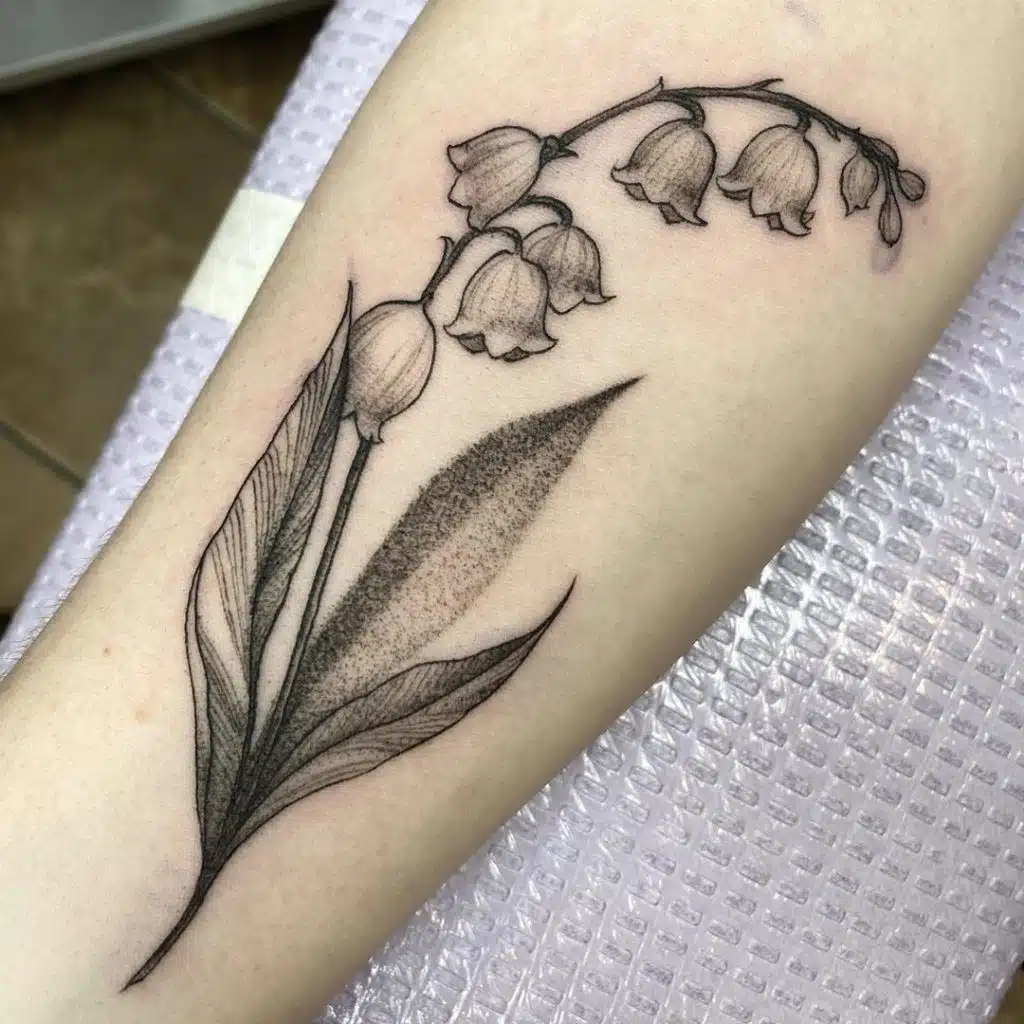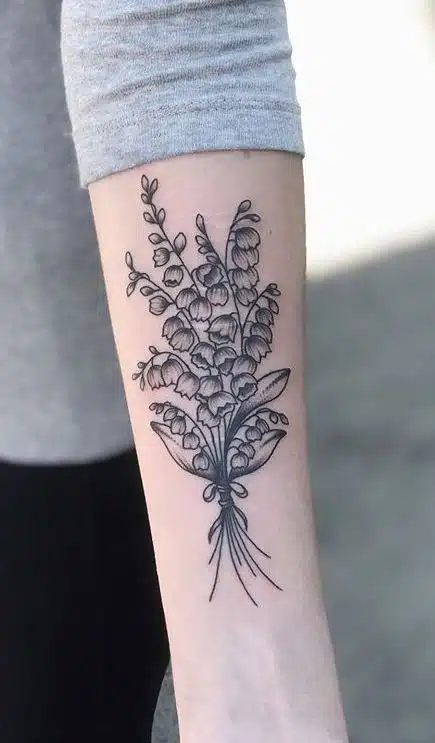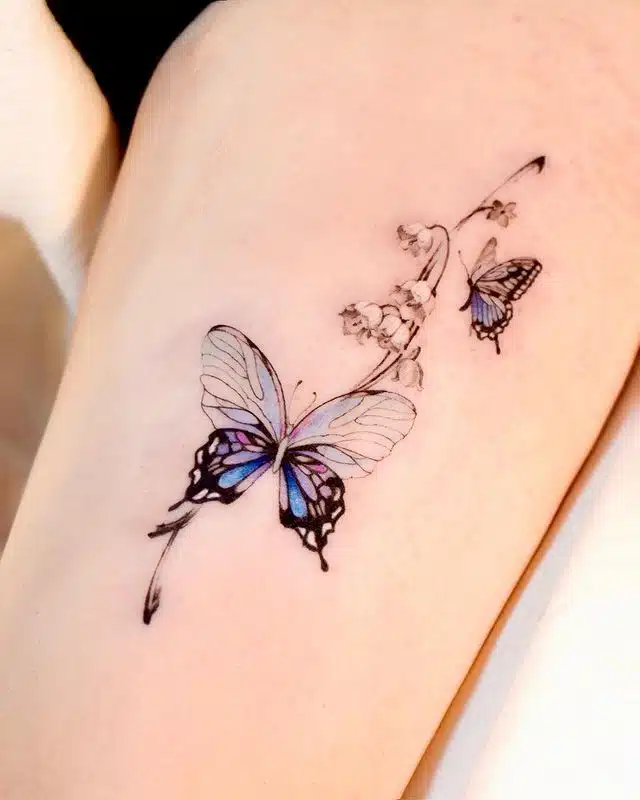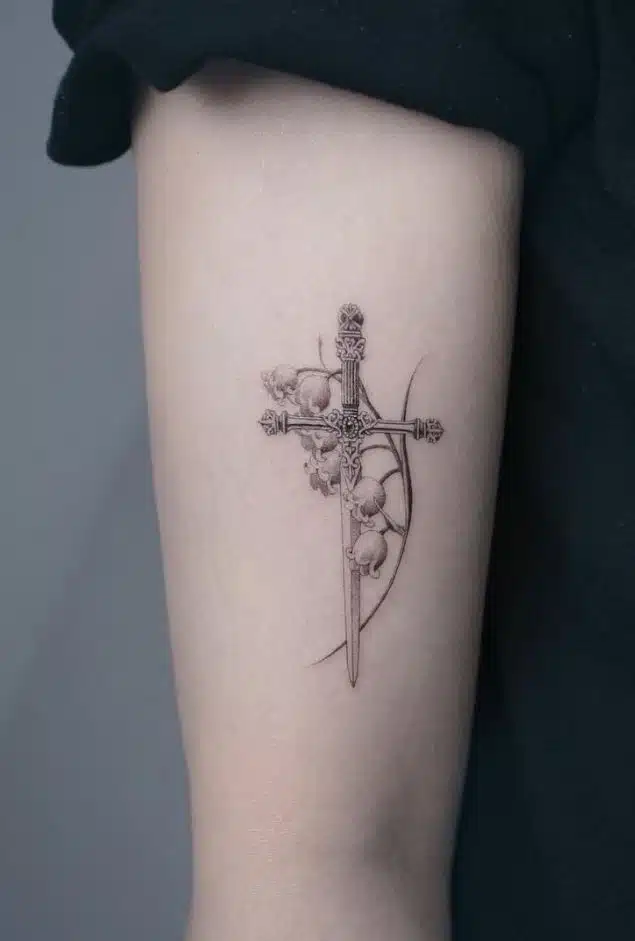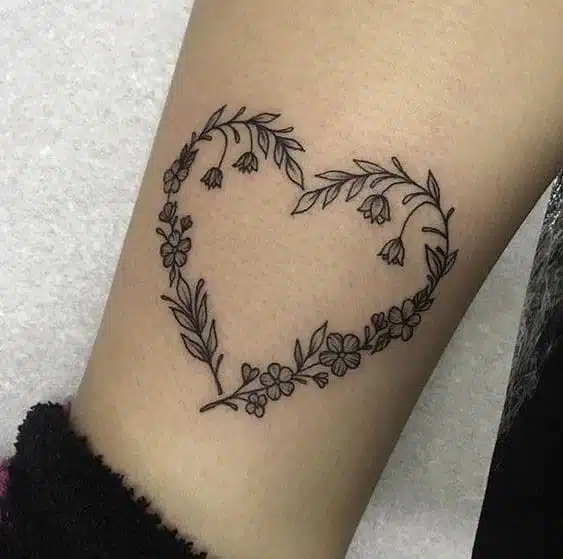A lily of the valley tattoo is a beautiful and meaningful choice for a first tattoo. In this blog post, we'll discuss the meaning and origin of the lily of the valley tattoo, as well as some of the most popular designs.
Are you only interested in tattoo designs and want to skip the educational part?
No problem, we got you covered! Click HERE to get inspired.
What does the Lily Of The Valley symbolize?
The Lily of the Valley is a delicate and fragrant flower that holds various symbolic meanings. Some of the common interpretations associated with the Lily of the Valley include:
Purity and Innocence: The flower is often associated with purity, innocence, and the Virgin Mary in Christian symbolism.
Happiness and Joy: It is considered a symbol of happiness, joy, and the return of happiness. It is sometimes associated with the arrival of spring and the rejuvenation of nature.
Good Luck: In some cultures, the Lily of the Valley is believed to bring good luck and is often included in bridal bouquets or given as a gift to wish someone good fortune.
Renewal and Rebirth: The flower's appearance in spring is often associated with renewal and the start of a new season. It is seen as a symbol of hope and new beginnings.
Love and Romance: The Lily of the Valley is sometimes regarded as a symbol of love and romance. It is associated with feelings of sweetness, humility, and devotion.
Protection: In folklore, the flower is believed to possess protective qualities and ward off evil spirits.
It's important to note that the symbolic meanings of flowers can vary across different cultures and contexts.
What does a Lily Of The Valley tattoo mean?
A Lily of the Valley tattoo can carry various meanings depending on the personal interpretation of the individual wearing it. Some common meanings associated with a Lily of the Valley tattoo include:
Beauty and Femininity: The delicate and elegant appearance of the Lily of the Valley is often seen as a representation of beauty, grace, and femininity.
Purity and Innocence: The flower's association with purity and innocence can be reflected in a tattoo as a symbol of one's own purity of heart, mind, or spirit.
Remembrance: The Lily of the Valley is sometimes chosen as a tattoo to honor or remember a loved one who has passed away. It can serve as a lasting tribute or a reminder of their presence.
New Beginnings and Hope: The flower's appearance in spring and its association with renewal can represent a fresh start, new beginnings, and a sense of hope for the future.
Joy and Happiness: A Lily of the Valley tattoo can symbolize a celebration of happiness, joy, and the pleasures of life.
Personal Significance: The meaning of a Lily of the Valley tattoo can also be deeply personal to the individual wearing it. It may represent a specific memory, experience, or sentiment that holds personal significance.
Ultimately, the interpretation of a Lily of the Valley tattoo is subjective and can vary from person to person. It is essential to consider the individual's personal connection to the flower and the specific context in which the tattoo is chosen.
Origin of the Lily of the Valley Tattoo Design
Lily of the valley tattoos is believed to have originated in Japan. The Japanese have a long tattooing history, dating back to at least 3000 BC. Tattooing was originally done for spiritual or religious purposes but later became associated with criminals and outcasts. In the late 1800s, Japanese immigrants brought tattooing to Hawaii, where it quickly became popular among sailors and fishermen. Tattooing then spread to Europe and America, where it was popularized by celebrities like Bam Bam Bigelow and Madonna.
best Lily Of The Valley Tattoo Designs
There are endless possibilities for design regarding lily of the valley tattoos. Some people get a small and simple tattoo featuring just a few lilies, while others opt for large and elaborate designs that cover their entire back or chest. Many choose to include other elements in their tattoo design, such as butterflies, birds, or leaves. Others prefer to keep their tattoo simple and elegant by featuring just a few lilies in bloom. Here are some of the most popular designs:
Single Lily of the Valley Tattoo
A single lily tattoo can represent beauty, innocence, or new beginnings. It can also be a memorial tattoo for a lost loved one.
Bouquet of Lilies of the Valley Tattoo
A bouquet of lilies is a symbol of purity, innocence, and new beginnings. It can also represent luck, wealth, and fertility.
Lily of the Valley Tattoo with Butterfly
This tattoo design is a symbol of transformation and new beginnings. The butterfly represents change and growth, while the lily of the valley represents purity and innocence
Lily of the Valley Tattoo with Cross
This tattoo design is a symbol of faith and hope. The cross represents faith, while the lily of the valley represents purity and innocence.
Lily of the Valley Tattoo with Heart
This tattoo design is a symbol of love and affection. The heart represents love, while the lily of the valley represents purity and innocence.
History of the Lily Of The Valley Tattoo in different cultures
The lily of the valley is a small, delicate flower with a sweet, fragrant scent that has been associated with a variety of cultural and symbolic meanings throughout history. In many cultures, the lily of the valley is seen as a symbol of purity, innocence, and rebirth, and it has been incorporated into tattoo designs for these reasons.
In Christianity, the lily of the valley is often associated with the Virgin Mary and is seen as a symbol of purity, humility, and devotion. It is also believed to represent the tears of the Virgin Mary, and is sometimes referred to as the "tear flower." In this context, a lily of the valley tattoo could be seen as a symbol of devotion to one's faith or as a tribute to the Virgin Mary.
In Japanese culture, the lily of the valley is known as the "suzuran," or "little bell flower," and is associated with purity and innocence. In this context, a lily of the valley tattoo could be seen as a symbol of innocence or a reminder to stay pure and true to oneself.
In French culture, the lily of the valley is a symbol of luck and good fortune, and is often given as a gift on the first of May to bring good luck to the recipient. In this context, a lily of the valley tattoo could be seen as a symbol of good luck or a reminder to stay positive and hopeful.
Overall, the lily of the valley is a multifaceted symbol that has been associated with a variety of cultural and symbolic meanings throughout history. Its delicate, fragrant flowers and associations with purity, innocence, and rebirth make it a popular choice for tattoo designs.
General Breakdown Of Tattoo Pain Levels On Different Body Parts
Here is a breakdown of the different tattoo pain levels:
- Low: This level of pain is generally described as a mild discomfort or tickling sensation. It is similar to the sensation of getting a light scratch or scrape.
- Moderate: This level of pain is generally described as a moderate discomfort or aching sensation. It is similar to the sensation of getting a deep scratch or scrape or being pinched.
- High: This level of pain is generally described as a strong discomfort or throbbing sensation. It is similar to the sensation of getting a burn or being stung by a bee.
It's important to note that pain tolerance is highly individual and can vary greatly from person to person. Some people may find certain body parts more or less painful than others, and the same body part can be more or less painful for different people. Additionally, the level of pain can be affected by factors such as the size and location of the tattoo, the skill of the tattoo artist, and the individual's own pain threshold.
Tattoo placement pain level chart
Body Part | Pain Level | Explanation |
Forehead | Low | The forehead has few nerve endings, so it is not a particularly painful area. |
Eyebrows | Low | The eyebrows have few nerve endings, so the pain level is relatively low. |
Ear | Low | The ear is a relatively thin and fleshy area, so the pain level is low. |
Nostril | Low | The nostril is a small area with thin skin, so the pain level is low. |
Lip | Low to Moderate | The lip has more nerve endings than some other areas, so it may be slightly more painful. |
Cheek | Low to Moderate | The cheek has a moderate amount of nerve endings, so it may be slightly more painful. |
Moderate | The neck has a moderate amount of nerve endings, so it may be slightly more painful. | |
Chest | Moderate to High | The chest has a high concentration of nerve endings, so it can be quite painful. |
Abdomen | High | The abdomen has a high concentration of nerve endings, so it can be quite painful. |
Back | High | The back has a high concentration of nerve endings, so it can be quite painful. |
Shoulders | High | The shoulders have a high concentration of nerve endings, so they can be quite painful. |
Upper Arms | Moderate to High | The upper arms have a moderate to high concentration of nerve endings, so they can be somewhat painful. |
Elbows | High | The elbows have a high concentration of nerve endings, so they can be quite painful. |
Forearms | Moderate | The forearms have a moderate concentration of nerve endings, so they are not as painful as some other areas. |
Hands | High | The hands have a high concentration of nerve endings, so they can be quite painful. |
Lower Arms | Low to Moderate | The lower arms have a lower concentration of nerve endings, so they are not as painful as some other areas. |
Wrists | Low | The wrists have a low concentration of nerve endings, so they are not very painful. |
Lower Back | High | The lower back has a high concentration of nerve endings, so it can be quite painful. |
Buttocks | High | The buttocks have a high concentration of nerve endings, so they can be quite painful. |
Thighs | High | The thighs have a high concentration of nerve endings, so they can be quite painful. |
Knees | High | The knees have a high concentration of nerve endings, so they can be quite painful. |
Calves | Low to Moderate | The calves have a low to moderate concentration of nerve endings, so they are not as painful as some other areas. |
Ankles | Low | The ankles have a low concentration of nerve endings, so they are not very painful. |
Tattoo aftercare tips
Before getting a tattoo:
Choose a reputable tattoo artist and parlor. Research the artist's portfolio and read reviews from previous clients.
Consult with the artist about the design and placement of the tattoo.
Make sure you are in good health. If you have any medical conditions or are taking any medications that may affect your ability to heal, be sure to let your tattoo artist know.
Consider using a numbing cream to reduce pain during the tattooing process. These creams contain a numbing agent (such as lidocaine) that can be applied to the skin before the tattoo is done. It's important to follow the instructions on the numbing cream and to only use it as directed.
Avoid alcohol, caffeine, and other substances that can thin your blood for at least 24 hours before getting a tattoo.
Eat a healthy meal before your tattoo session to ensure that your blood sugar is stable.
Wear loose, comfortable clothing that allows easy access to the area being tattooed.
After getting a tattoo:
Follow the aftercare instructions provided by your tattoo artist. These may include:
Keeping the tattoo clean and covered with a bandage for the first few hours after getting tattooed.
Washing the tattoo with lukewarm water and a mild soap (such as unscented, antimicrobial soap) and patting it dry with a clean towel.
Applying a thin layer of tattoo ointment or lotion (such as A&D or Aquaphor) to the tattoo and covering it with a clean bandage or wrap.
Repeating this process for the first few days, or until the tattoo has fully scabbed over.
Avoid soaking the tattoo in water for the first week, such as in a bath or pool.
Avoid picking or scratching at the scabs, as this can cause the tattoo to fade or become infected.
Avoid exposure to direct sunlight or tanning beds for at least 2-4 weeks.
If you experience any redness, swelling, or unusual discharge, contact your tattoo artist or a healthcare professional.
Overall, it's important to keep your tattoo clean and moisturized during the healing process to ensure that it heals properly and looks its best. Using a numbing cream can help reduce pain during the tattooing process, but it's important to use it as directed and to follow all aftercare instructions to ensure that your tattoo heals properly.
People Also Ask:
What do lily flowers represent?
Lily of the valley flowers represents purity, innocence, sweetness, and humility. The lily is also associated with motherhood and new beginnings.
What does Lily of the Valley symbolize?
The lily of the valley is a symbol of purity, innocence, and new beginnings. It's also said to represent luck, wealth, and fertility.
How much does a Lily of the Valley tattoo cost?
The average cost of a small lily of the valley tattoo is $50-$100. The price will increase depending on the tattoo's size, complexity, and location.
What do the colors mean in a lily tattoo?
The colors of a lily tattoo can have different meanings depending on the culture. In Japan, for example, white lilies are associated with death and mourning, while red lilies are associated with love and passion.
How do you take care of a lily of the valley tattoo?
To care for a new lily tattoo, it's important to keep the area clean and moisturized. Avoid sun exposure and swimming for the first few weeks. Follow your artist's aftercare instructions and contact them if you have any concerns.
Watch A Time-Lapse Video Of A lily of the valley Tattoo Done By A Pro:
180+ Lily Of The Valley Tattoo Ideas For Your Inspiration
Final Thoughts
If you're looking for a beautiful and meaningful tattoo design, look no further than the lily of the valley. This timeless symbol represents purity, innocence, new beginnings, and luck. Lily of the valley tattoos is also said to represent wealth and fertility. Whether you opt for a small and simple design or an elaborate full-body piece, there's sure to be a lily of the valley tattoo perfect for you!

